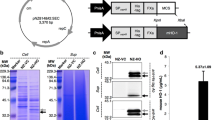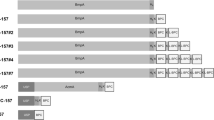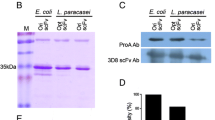Abstract
Prolyl endopeptidases (PEP) (EC 3.4.21.26), a family of serine proteases with the ability to hydrolyze the peptide bond on the carboxyl side of an internal proline residue, are able to degrade immunotoxic peptides responsible for celiac disease (CD), such as a 33-residue gluten peptide (33-mer). Oral administration of PEP has been suggested as a potential therapeutic approach for CD, although delivery of the enzyme to the small intestine requires intrinsic gastric stability or advanced formulation technologies. We have engineered two food-grade Lactobacillus casei strains to deliver PEP in an in vitro model of small intestine environment. One strain secretes PEP into the extracellular medium, whereas the other retains PEP in the intracellular environment. The strain that secretes PEP into the extracellular medium is the most effective to degrade the 33-mer and is resistant to simulated gastrointestinal stress. Our results suggest that in the future, after more studies and clinical trials, an engineered food-grade Lactobacillus strain may be useful as a vector for in situ production of PEP in the upper small intestine of CD patients.







Similar content being viewed by others
References
Alvarez MA, Herrero M, Suárez JE (1998) The site-specific recombination system of the Lactobacillus species bacteriophage A2 integrates in gram-positive and gram-negative bacteria. Virology 250(1):185–193. doi:10.1006/viro.1998.9353
Axelsson L (1998) Lactic acid bacteria: Classification and physiology. In: Salminen SVWA (ed) Lactic acid bacteria: Microbiological and functional aspects, 2nd edn. CRC, Boca Raton, pp 1–66
Bethune MT, Khosla C (2012) Oral enzyme therapy for celiac sprue. Methods Enzymol 502:241–271
Carr FJ, Chill D, Maida N (2002) The lactic acid bacteria: a literature survey. Crit Rev Microbiol 28(4):281–370. doi:10.1080/1040-840291046759
Charteris, Kelly, Morelli, Collins (1998) Development and application of an in vitro methodology to determine the transit tolerance of potentially probiotic Lactobacillus and Bifidobacterium species in the upper human gastrointestinal tract. J Appl Microbiol 84(5):759–768. doi:10.1046/j.1365-2672.1998.00407.x
Clarke G, Cryan JF, Dinan TG, Quigley EM (2012) Review article: probiotics for the treatment of irritable bowel syndrome—focus on lactic acid bacteria. Aliment Pharmacol Ther 35(4):403–413. doi:10.1111/j.1365-2036.2011.04965.x
Comino I, Real A, Vivas S, Síglez MÁ, Caminero A, Nistal E, Casqueiro J, Rodríguez-Herrera A, Cebolla Á, Sousa C (2012) Monitoring of gluten-free diet compliance in celiac patients by assessment of gliadin 33-mer equivalent epitopes in feces. Am J Clin Nutr 95(3):670–677. doi:10.3945/ajcn.111.026708
Conway PL, Gorbach SL, Goldin BR (1987) Survival of lactic acid bacteria in the human stomach and adhesion to intestinal cells. J Dairy Sci 70(1):1–12. doi:10.3168/jds.S0022-0302(87)79974-3
Corrao G, Corazza GR, Bagnardi V, Brusco G, Ciacci C, Cottone M, Sategna Guidetti C, Usai P, Cesari P, Pelli MA, Loperfido S, Volta U, Calabro A, Certo M (2001) Mortality in patients with coeliac disease and their relatives: a cohort study. Lancet 358(9279):356–361. doi:http://www.ncbi.nlm.nih.gov/pubmed/11502314
Daniel C, Roussel Y, Kleerebezem M, Pot B (2011) Recombinant lactic acid bacteria as mucosal biotherapeutic agents. Trends Biotechnol 29(10):499–508. doi:10.1016/j.tibtech.2011.05.002
D'Arienzo R, Maurano F, Luongo D, Mazzarella G, Stefanile R, Troncone R, Auricchio S, Ricca E, David C, Rossi M (2008) Adjuvant effect of Lactobacillus casei in a mouse model of gluten sensitivity. Immunol Lett 119(1–2):78–83 doi:10.1016/j.imlet.200804.006
D'Arienzo R, Stefanile R, Maurano F, Mazzarella G, Ricca E, Troncone R, Auricchio S, Rossi M (2011) Immunomodulatory effects of Lactobacillus casei administration in a mouse model of gliadin-sensitive enteropathy. Scand J Immunol 74(4):335–341. doi:10.1111/j.1365-3083.2011.02582.x
del Rio B, Dattwyler RJ, Aroso M, Neves V, Meirelles L, Seegers JFML, Gomes-Solecki M (2008) Oral immunization with recombinant Lactobacillus plantarum induces a protective immune response in mice with Lyme disease. Clin Vaccine Immunol 15(9):1429–1435. doi:10.1128/cvi.00169-08
del Rio B, Fuente JL, Neves V, Dattwyler R, Seegers JFML, Gomes-Solecki M (2010) Platform technology to deliver prophylactic molecules orally: an example using the class A select agent Yersinia pestis. Vaccine 28(41):6714–6722. doi:10.1016/j.vaccine.2010.07.084
Fernández de Palencia P, López P, Corbí AL, Peláez C, Requena T (2008) Probiotic strains: survival under simulated gastrointestinal conditions, in vitro adhesion to Caco-2 cells and effect on cytokine secretion. Eur Food Res Technol 227(5):1475–1484. doi:10.1007/s00217-008-0870-6
Gass J, Ehren J, Strohmeier G, Isaacs I, Khosla C (2005) Fermentation, purification, formulation, and pharmacological evaluation of a prolyl endopeptidase from Myxococcus xanthus: implications for Celiac Sprue therapy. Biotechnol Bioeng 92(6):674–684. doi:10.1002/bit.20643
Green PH, Jabri B (2003) Coeliac disease. Lancet 362(9381):383–391
Gujral N, Freeman HJ, Thomson AB (2012) Celiac disease: prevalence, diagnosis, pathogenesis and treatment. World J Gastroenterol 18(42):6036–6059. doi:10.3748/wjg.v18.i42.6036
Hausch F, Shan L, Santiago NA, Gray GM, Khosla C (2002) Intestinal digestive resistance of immunodominant gliadin peptides. Am J Physiol Gastrointest Liver Physiol 283(4):G996–G1003. doi:10.1152/ajpgi.00136.2002
Jankovic I, Ventura M, Meylan V, Rouvet M, Elli M, Zink R (2003) Contribution of aggregation-promoting factor to maintenance of cell shape in Lactobacillus gasseri 4B2. J Bacteriol 185(11):3288–3296. doi:10.1128/jb.185.11.3288-3296.2003
Janssen GR, Bibb MJ (1993) Derivatives of pUC18 that have BgfII sites flanking a modified multiple cloning site and that retain the ability to identify recombinant clones by visual screening of Escherichia coli colonies. Gene 124(1):133–134. doi:10.1016/0378-1119(93)90774-W
Kabashima T, Fujii M, Meng Y, Ito K, Yoshimoto T (1998) Prolyl endopeptidase from Sphingomonas capsulata: isolation and characterization of the enzyme and nucleotide sequence of the gene. Arch Biochem Biophys 358(1):141–148. doi:10.1006/abbi.1998.0836
Laemmli UK (1970) Cleavage of structural proteins during the assembly of the head of bacteriophage T4. Nature 227:680–685
Marcotte H, Ferrari S, Cesena C, Hammarström L, Morelli L, Pozzi G, Oggioni MR (2004) The aggregation-promoting factor of Lactobacillus crispatus M247 and its genetic locus. J Appl Microbiol 97(4):749–756. doi:10.1111/j.1365-2672.2004.02364.x
Marietta EV, Murray JA (2012) Animal models to study gluten sensitivity. Semin Immunopathol 34(4):497–511. doi:10.1007/s00281-012-0315-y
Marteau P, Minekus M, Havenaar R, Huisin’t Veld JHJ (1997) Survival of lactic acid bacteria in a dynamic model of the stomach and small intestine: validation and the effects of bile. J Dairy Sci 80(6):1031–1037. doi:10.3168/jds.S0022-0302(97)76027-2
Marti T, Molberg O, Li Q, Gray GM, Khosla C, Sollid LM (2005) Prolyl endopeptidase-mediated destruction of T cell epitopes in whole gluten: chemical and immunological characterization. J Pharmacol Exp Ther 312(1):19–26. doi:10.1124/jpet.104.073312
Martin MC, Alonso JC, Suarez JE, Alvarez MA (2000) Generation of food-grade recombinant lactic acid bacterium strains by site-specific recombination. Appl Environ Microbiol 66(6):2599–2604
Martin MC, Fernandez M, Martin-Alonso JM, Parra F, Boga JA, Alvarez MA (2004) Nisin-controlled expression of Norwalk virus VP60 protein in Lactobacillus casei. FEMS Microbiol Lett 237(2):385–391. doi:10.1016/j.femsle.2004.07.002
Martin MC, Pant N, Ladero V, Gunaydin G, Andersen KK, Alvarez B, Martinez N, Alvarez MA, Hammarstrom L, Marcotte H (2011) Integrative expression system for delivery of antibody fragments by lactobacilli. Appl Environ Microbiol 77(6):2174–2179. doi:10.1128/AEM.02690-10
Mazé A, Boël G, Zúñiga M, Bourand A, Loux V, Yebra MJ, Monedero V, Correia K, Jacques N, Beaufils S, Poncet S, Joyet P, Milohanic E, Casarégola S, Auffray Y, Pérez-Martínez G, Gibrat J-F, Zagorec M, Francke C, Hartke A, Deutscher J (2010) Complete genome sequence of the probiotic Lactobacillus casei strain BL23. J Bacteriol 192(10):2647–2648. doi:10.1128/jb.00076-10
Nyanga-Koumou AP, Ouoba LII, Kobawila SC, Louembe D (2012) Response mechanisms of lactic acid bacteria to alkaline environments: a review. Crit Rev Microbiol 38(3):185–190. doi:10.3109/1040841X.2011.640978
Parish JH (1986) Genetic manipulation of Streptomyces—a laboratory manual: by D A Hopwood, M J Bibb, K F Chatter; T Kieser CJ Bruton, H M Kieser, D J Lydiate, C P Smith, J M Ward and H Schrempf. pp 356. The John Innes Foundation, Norwich, UK and Cold Spring Harbour Laboratory. 1985. ISBN 0-7084-0336-0. Biochem Educ 14(4):196–196
Piper JL, Gray GM, Khosla C (2004) Effect of prolyl endopeptidase on digestive-resistant gliadin peptides in vivo. J Pharmacol Exp Ther 311(1):213–219. doi:10.1124/jpet.104.068429
Pyle GG, Paaso B, Anderson BE, Allen DD, Marti T, Li Q, Siegel M, Khosla C, Gray GM (2005) Effect of pretreatment of food gluten with prolyl endopeptidase on gluten-induced malabsorption in celiac sprue. Clin Gastroenterol Hepatol 3(7):687–694
Qiao SW, Bergseng E, Molberg O, Xia J, Fleckenstein B, Khosla C, Sollid LM (2004) Antigen presentation to celiac lesion-derived T cells of a 33-mer gliadin peptide naturally formed by gastrointestinal digestion. J Immunol 173(3):1757–1762
Sambrook J, Fritsch EF, Maniatis T (1989) Molecular cloning: A laboratory manual, 2nd edn. Cold Spring Harbor Laboratory Press, Cold Spring Harbor
Sánchez B, Schmitter JM, Urdaci MC (2009) Identification of novel proteins secreted by Lactobacillus rhamnosus GG grown in de Mann–Rogosa–Sharpe broth. Lett Appl Microbiol 48(5):618–622. doi:10.1111/j.1472-765X.2009.02579.x
Savijoki K, Ingmer H, Varmanen P (2006) Proteolytic systems of lactic acid bacteria. Appl Microbiol Biotechnol 71(4):394–406. doi:10.1007/s00253-006-0427-1
Scheirlinck T, Mahillon J, Joos H, Dhaese P, Michiels F (1989) Integration and expression of alpha-amylase and endoglucanase genes in the Lactobacillus plantarum chromosome. Appl Environ Microbiol 55(9):2130–2137
Schuppan D, Junker Y, Barisani D (2009) Celiac disease: from pathogenesis to novel therapies. Gastroenterology 137(6):1912–1933. doi:10.1053/j.gastro.2009.09.008
Sealey-Voyksner JA, Khosla C, Voyksner RD, Jorgenson JW (2010) Novel aspects of quantitation of immunogenic wheat gluten peptides by liquid chromatography–mass spectrometry/mass spectrometry. J Chromatogr A 1217(25):4167–4183. doi:10.1016/j.chroma.2010.01.067
Shan L, Molberg O, Parrot I, Hausch F, Filiz F, Gray GM, Sollid LM, Khosla C (2002) Structural basis for gluten intolerance in celiac sprue. Science 297(5590):2275–2279. doi:10.1126/science.1074129
Shan L, Marti T, Sollid LM, Gray GM, Khosla C (2004) Comparative biochemical analysis of three bacterial prolyl endopeptidases: implications for coeliac sprue. Biochem J 383(Pt 2):311–318. doi:10.1042/BJ20040907
Stoven S, Murray JA, Marietta EV (2013) Latest in vitro and in vivo models of celiac disease. Expert Opin Drug Discov 8(4):445–457. doi:10.1517/17460441.2013.761203
Tuohy KM, Probert HM, Smejkal CW, Gibson GR (2003) Using probiotics and prebiotics to improve gut health. Drug Discov Today 8(15):692–700. doi:10.1016/S1359-6446(03)02746-6
Turroni F, Ventura M, Buttó LF, Duranti S, O'Toole PW, Motherway MOC, Sinderen D (2013) Molecular dialogue between the human gut microbiota and the host: a Lactobacillus and Bifidobacterium perspective. Cell Mol Life Sci 1–21. doi: 10.1007/s00018-013-1318-0
van Overbeek FM, Uil-Dieterman IG, Mol IW, Kohler-Brands L, Heymans HS, Mulder CJ (1997) The daily gluten intake in relatives of patients with coeliac disease compared with that of the general Dutch population. Eur J Gastroenterol Hepatol 9(11):1097–1099
Ventura M, Jankovic I, Walker DC, Pridmore RD, Zink R (2002) Identification and characterization of novel surface proteins in Lactobacillus johnsonii and Lactobacillus gasseri. Appl Environ Microbiol 68(12):6172–6181. doi:10.1128/aem.68.12.6172-6181.2002
Vieira J, Messing J (1991) New pUC-derived cloning vectors with different selectable markers and DNA replication origins. Gene 100:189–194
Wang J, Zhong Z, Zhang W, Bao Q, Wei A, Meng H, Zhang H (2012) Comparative analysis of the gene expression profile of probiotic Lactobacillus casei Zhang with and without fermented milk as a vehicle during transit in a simulated gastrointestinal tract. Res Microbiol 163(5):357–365. doi:10.1016/j.resmic.2012.04.002
Wei M-Q, Rush CM, Norman JM, Hafner LM, Epping RJ, Timms P (1995) An improved method for the transformation of Lactobacillus strains using electroporation. J Microbiol Methods 21(1):97–109. doi:10.1016/0167-7012(94)00038-9
Wells J, Mercenier A (2008) Mucosal delivery of therapeutic and prophylactic molecules using lactic acid bacteria. Nat Rev Microbiol 6(5):349–362. doi:10.1038/nrmicro1040
Yoshimoto T, Walter R, Tsuru D (1980) Proline-specific endopeptidase from Flavobacterium. Purification and properties. J Biol Chem 255(10):4786–4792
Yoshimoto T, Kanatani A, Shimoda T, Inaoka T, Kokubo T, Tsuru D (1991) Prolyl endopeptidase from Flavobacterium meningosepticum: cloning and sequencing of the enzyme gene. J Biochem 110(6):873–878
Acknowledgments
The authors are grateful to Isabel Cuesta and Jorge R. Álvarez-Buylla for their technical assistance. This research was supported by project 201370E094 from the CSIC. P.A. is the recipient of a fellowship from FICYT (BP09093) and B.D.R. is a beneficiary of a JAE-DOC contract (CSIC). C.K. is supported by a grant from the NIH (R01 DK 063158).
Author information
Authors and Affiliations
Corresponding author
Rights and permissions
About this article
Cite this article
Alvarez-Sieiro, P., Martin, M.C., Redruello, B. et al. Generation of food-grade recombinant Lactobacillus casei delivering Myxococcus xanthus prolyl endopeptidase. Appl Microbiol Biotechnol 98, 6689–6700 (2014). https://doi.org/10.1007/s00253-014-5730-7
Received:
Revised:
Accepted:
Published:
Issue Date:
DOI: https://doi.org/10.1007/s00253-014-5730-7




